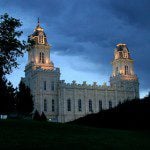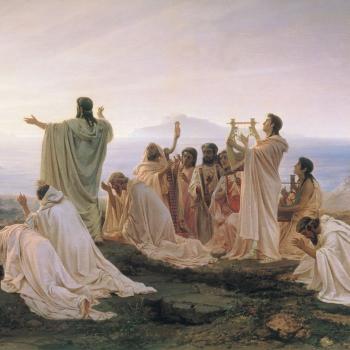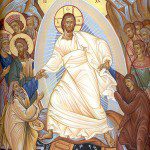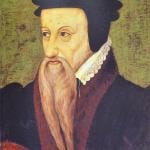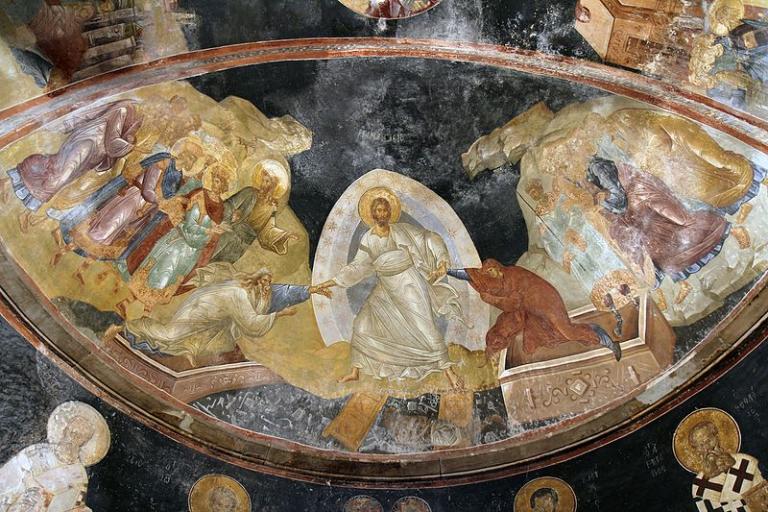
(Wikimedia Commons public domain image)
I published this column in the Deseret News on Thursday, 21 April 2011. It would have been more appropriate for me to have re-posted it two days ago, but, to coin an entirely original phrase, better late than never. In any event, it’s mostly about “Holy Saturday”:
Today is Maundy Thursday. The derivation of the word “Maundy” is disputed, but this is the fifth day of Holy Week or Passion Week — the term “passion” refers not to emotions in our modern sense, but to Christ’s suffering — which began last weekend on Palm Sunday. For hundreds of millions of Christians worldwide, it recalls the Last Supper of Jesus and his apostles.
After that Passover meal, Jesus and his followers walked to the Garden of Gethsemane, where he apparently often went to pray. He withdrew himself, and, as Latter-day Saints understand, commenced there the awesome and mysterious process of his atonement for the sins of humanity.
However, a communal celebration of goodness and hope was marred, as so many human things are, by wickedness (Judas’ treachery), and was followed by stunning violence and injustice. Such, too often, is the world in which we live.
Tomorrow is Good Friday. (The word “good” should be understood in one of its old, archaic meanings: “holy” or “pious.”) It marks the crucifixion of Jesus Christ and his death on Calvary.
The messianic dreams of Jesus’ disciples had, it seemed, been destroyed. The man in whom they trusted was dead. They were scattered as sheep without a shepherd.
What they do not seem to have fully understood — who can? — is that their leader’s violent, humiliating death, his apparent defeat, represented part of the greatest victory in this world’s history. His cry “It is finished” marked the culmination of the Atonement, his triumph over sin. It opened the door for all of us, if we will, to return into God’s presence.
Holy Saturday, the last day of Holy Week and the day before Easter, follows Good Friday. It commemorates the day that Jesus’ broken body lay dead in the tomb. It represents an interim period, a time of waiting and uncertainty.
Modern believers in the Restoration, however, understand that, even while his body lay dead and motionless, Jesus’ immortal spirit was preaching to the spirits in prison, inaugurating the great work of the redemption of the dead that is carried on now in our temples. We may not always see God visibly at work from our vantage point in this fallen world, encircled by the veil, but he is always working for our salvation.
On that ancient Saturday, though, the apostles were hiding, their hopes dashed, not knowing what to do, perhaps anticipating their own arrest and execution.
Many of us are living our own Saturday, holy or unholy. Evil and injustice frequently seem to have the upper hand in the world around us, and indeed in our own lives. We’re fearful and uncertain. Often, we’ve been defeated, and perhaps we feel that any significant victory is beyond our reach. We’re worn out. We’ve heard promises of wonderful things to come, but we’re unsure of them. Commonly, our days seem very dark. Have we believed in vain?
But the testimony of the Four Gospels, of the first apostles, of the early Christians, of Christian believers throughout the centuries and of the Prophet Joseph Smith and his apostolic successors is that, early on Sunday morning, the stone had been rolled away and the tomb was empty. Jesus had risen.
And, for all of us, Easter will come. Our Saturday of uncertainty and defeat does not, will not, continue forever. As the great English mystic Julian of Norwich (deceased circa 1416) so simply but memorably expressed the Christian hope, in words that she said had been given her by God, “All shall be well, and all shall be well, and all manner of things shall be well.”
Good Friday, Holy Saturday and Easter Sunday commemorate the passion, death and resurrection of Jesus and constitute what is sometimes called, in mainstream Christianity, the Holy Triduum (“three days”).
Whenever we partake of the sacrament, the events of these days should be central to our reflections. They should be at the center of our thoughts over the next few days, as well.
“The fundamental principles of our religion,” Joseph Smith said, “are the testimony of the Apostles and Prophets, concerning Jesus Christ, that He died, was buried, and rose again the third day, and ascended into heaven; and all other things which pertain to our religion are only appendages to it” (“Teachings of the Prophet Joseph Smith,” 121).
***
With “Holy Saturday” and Easter in mind, and also the coronavirus pandemic and yesterday’s worldwide fast, two passages from the Hebrew Bible have been on my mind since this morning:
“Be still, and know that I am God” (Psalm 46:10)
“Fear ye not, stand still, and see the salvation of the Lord, which he will shew to you to day.” (Exodus 14:13)
COVID-19, meet the Savior.
***
This worthwhile piece appeared just today in the Deseret News:
“In our opinion: Use Holy Saturday to regroup, reflect and rejuvenate”
***
Today is the day of Christ’s “Harrowing of Hell,” his descent into the spirit world:
“Descensus Christi ad Inferos”
Latter-day Saints are wonderfully blessed, in this connection, to have in their scriptural canon an account of the great “Vision of the Redemption of the Dead” given to President Joseph F. Smith slightly more than a century ago, on 3 October 1918. Appropriately to our present circumstances, that revelation was received nearly midway through the great worldwide Spanish flu pandemic (La Pesadilla, “The Nightmare”) that, close on the heels of World War One, killed somewhere between 17 million and 100 million people worldwide during the two years from January 1918 to December 1920:
For an excellent account of the historical context of President Smith’s remarkable vision, see George S. Tate, “The Great World of the Spirits of the Dead: Death, the Great War, and the 1918 Influenza Pandemic as Context for Doctrine and Covenants 138,” BYU Studies 46/1:
Joseph F. Smith, “Vision of the Redemption of the Dead”
***
A marvelous article out of the still-Catholic portion of Spain:
***
And here’s something of relevant interest regarding the history of science:



